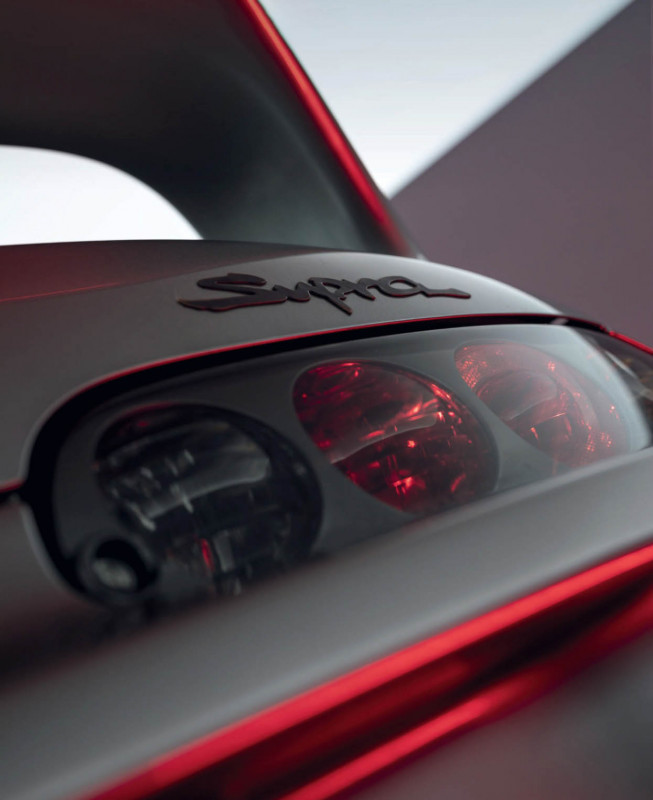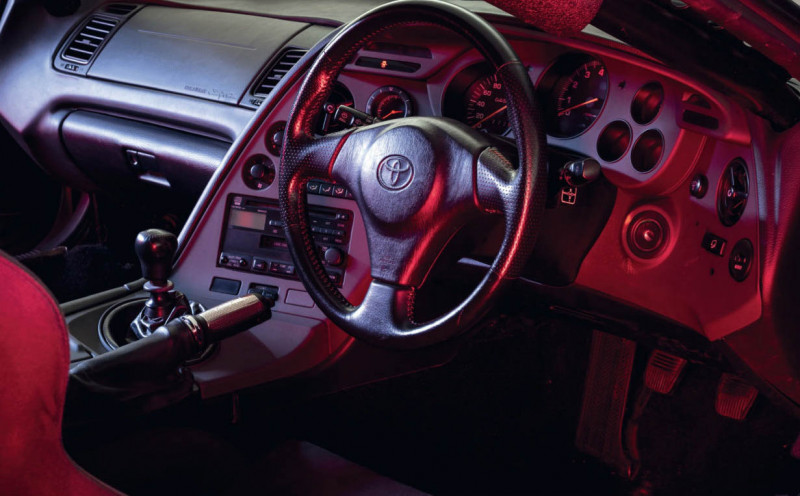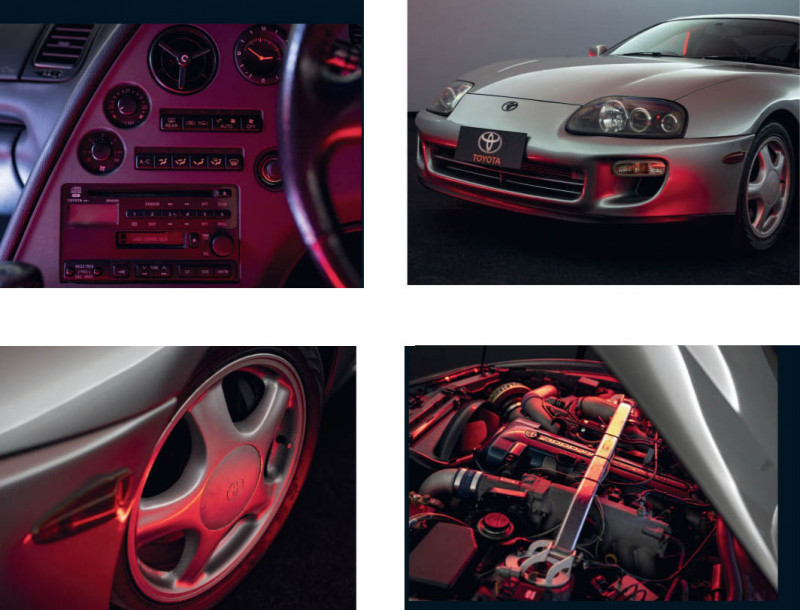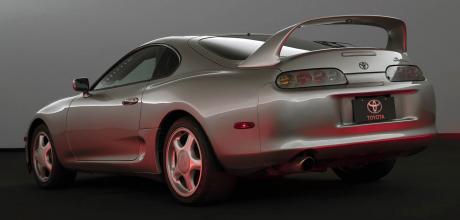1993-2002 Toyota Supra RZ A80
More than three decades since it was launched, the A80 Supra’s appeal has never waned. We examine why.
PHOTOS ELLEN DEWAR
Overrun — MODERN CLASSIC
The fourth-gen Toyota Supra was one of the best performance cars never offered in Australia. So what happened?

Hero cars don’t come a whole lot more heroic than the fourth-generation Toyota Supra. All of the ingredients are in place: a cult following spawned from bombproof mechanicals, a classic front-engine, rear-drive layout with the option of a manual gearbox and two turbos, 1990s Japanese bubble-era appeal, muscular coupe styling, silver-screen provenance, the original Gran Turismo seal of approval and genuine giant-killing ability. All it’s missing is a cape. As with any vehicle that gets the big build-up, you probably have questions. Lots of them. Above all, does the Supra live up to the hype? Is it a better bet than contemporaries such as the Mazda RX-7 or the Nissan 300ZX?

The Supra was different to what went before it. Yes, it shared the basic bones of the Soarer/Lexus SC, but ran on a 2540mm wheelbase, some 150mm shorter than the more laid-back Soarer. Unlike any Toyota product before, it was developed at the Nürburgring. Toyota master driver Hiromi Naruse had campaigned a Celica 1600GT at the Nordschleife in the 1970 6-Hours of Nürburgring event.
The first time he drove the Green Hell, the 28-year-old Naruse realised “I have come to an extraordinary place” and, at the same time, knew that “we can use the Nürburgring for development.” By 1988, development of the fourth-generation Supra, under the auspices of chief engineer Isao Tsuzuki, saw extensive chassis and powertrain work conducted at the Ring. The evaluation driver? Naruse.

“We’re not satisfied with the situation just because the Supra is superior to other cars at Japanese circuits. The car will not show the true potential at circuits in Japan. Japanese circuits only reveal one-tenth of a car’s performance, but the Nürburgring uncovers 100 percent of a car’s capabilities,” explained Naruse. “For this reason, it is impossible to misrepresent the car at the Nürburgring. The faster the average speed, the more the Supra is able to show its inherent performance. When it is brought to Europe, the Supra will demonstrate just how good it is.”
But did it? Autocar’s road test in September 1993 surmised that “the Supra is as fast and modern as its predecessor was slow and outdated… point-to-point on a twisty road it’s hard to think of another front-engined car that would even keep up.” The numb steering and lack of rear-seat practicality versus the BMW E36 M3 were criticised, and the title’s more enthusiast drivers still preferred Mazda’s FD RX-7 as a corner carver.
When Wheels got hold of a Supra on these shores, it sat Bob Hall in the driver’s seat and put it up against the Lexus SC400, which Hall preferred. That was in 1996, and the grey imported RZ model was, at the time, priced at an eye-watering $148,000. That’d be around $270,000 in today’s money, which makes its BMW-based successor look a steal. Hall was less enamoured of the Supra’s ride and rated the Lexus’s V8 over the 2JZ GTE six in the Toyota.

So far so underwhelming. But that doesn’t take into account the influence of Smokey Nagata, the lemon-yellow Jun missiles, Keiichi Tsuchiya with armfuls of opposite lock on worn Best Motoring VHS tapes, Vin Diesel and Paul Walker in Fast & Furious, and, of course, all of the weird and wonderful JGTC cars brought straight into our bedrooms by Gran Turismo (what the heck is Zent or SARD anyway?). For a whole generation of kids, a Castrol-liveried Supra with 1000 horsepower as seen on their OG Playstation is every bit as legitimate an automotive icon as anything that ever rolled out of the gates of Maranello. Suppress a condescending chuckle if you like, but as a car that fired up the enthusiasm of a whole new generation of petrolheads, little holds a candle to the Supra.
At this point – and we can delay it no longer – we need to bite the bullet and wade into the tangled web that is Supra variant list. The easiest way to slice and dice it is to divide the Supra into naturally aspirated and twin-turbocharged versions and also into pre-facelift (1993-1997) and post-facelift (1997-2002) cars. The early 164kW atmo cars comprised the base SZ, which was joined in 1994 by the more focused SZ-R and SZ-R Aerotop. The first twin-turbo cars were the RZ, the GZ and the GZ Aerotop. In 1995, the RZ became manual only and the RZ-S replaced the auto version. A four-speed automatic was offered but if you preferred three pedals, turbocharged models featured the bombproof six-speed Getrag/Toyota V160 manual (and later V161) gearbox while atmo cars had to make do with the carried over older (and weaker) five-speed manual W58 ’box.
The facelift arrived in 1997 whereupon the VVT-i engines debuted in the base SZ, the manual-only SZ-R, the short-lived SZ-R Aerotop, the RZ-S and the aggressive RZ manual. It’s worth noting that Toyota didn’t manage to accurately marry together the facelift and the introduction of the VVT-i engines, with some early facelift cars carrying the previous powerplant until September of that year. Supra exports ceased in 1998, with limited production of Japanese domestic market vehicles extending through to 2002.
Operating in a sphere outside of these Japanese models is the UK-spec Supra TT, on sale from 1993 to 1996 and a recipient of steel rather than ceramic turbochargers, a power output of 243kW rather than the Japanese initial standard 206kW (239kW for other export markets) and fitments such as leather upholstery throughout, a bonnet scoop, glass headlamps with washers, heated front seats and an outside temperature gauge. Other gear fitted solely to this variant include exhaust gas recirc, a diff cooler, higher capacity injectors and fuel pump and (on auto models) a gearbox cooler. It seems a lot of effort to go to in order create the alpha and omega of Supras which would shift a mere 250 units a year for three years.
While the exchange rate killed the Supra’s chances on these shores, it ensured a healthy parallel import business. What’s more, the Australian mix of Supras skews heavily towards manual cars. You’ll need from $35,000 for the first of the atmo versions and around $80K to start negotiations on a twin-turbo model, with really clean, low-mileage turbo manuals easily topping six figures. That’s around the prices for good FD RX-7s, a tier above comparable Mitsubishi 3000 GTOs and Nissan 300ZXs and a bracket or two down from Nissan R32 GT-Rs and Honda NSXs.
By today’s standards a Supra isn’t the monster GT car it seemed at launch. At 4520mm long and 1810mm wide, its footprint on the road is smaller than something like a BMW M2. Its weight figure seems pretty contemporary too, the atmo cars tipping the scales from 1410kg and turbo versions starting at 1490kg. That’s partly down to the fact that the bonnet, the front suspension cross member, all four upper wishbones and the engine mounts were fabricated from aluminium. A polyethylene fuel tank shaved a further 4kg and even the rear wing was made of a hollow resin.
Unmodified cars are hard to come by, but the Supra twin-turbo experience was of a car that was quiet at idle, with a firmish ride, a cultured straight-six yowl towards the top end that still makes it feel rapid. Slightly vague steering combined with the elastic, boosty feel when the big turbo chimes in engenders a certain respect for limits. Buying a Supra is largely an exercise in weeding out those that have been obviously abused. Values are now heading in a directionare as strong as the internet memes suggest. Atmo VVT-i engines are an interference design, which means that you’ll need to pay particular attention to when the cam belt has been changed. The same goes for turbos with modified cam profiles, so make sure the 96,000km / 72-month change has been performed. Also ask the previous owner about oil servicing and check for air locks in the coolant system. Grey or white smoke and a sweet smell from the exhaust is evidence of a coolant leak, probably from the head gasket. If you can smell the exhaust when the car’s idling, it may well have been decatted.
Coil packs are a common failure point and engine mounts can wear, as can valve stem seals. Both are a relatively easy repair. Slow acceleration, late boosting, oil consumption, an engine boosting late or exhibiting death whine can mean that a turbocharger is on its last legs. Some owners like to swap out the original dual turbos for a simpler single setup, and often choose one that is capable of making higher output figures at the expense of initial low-end response. If this has been done, ensure that allied driveline parts such as the clutch has been uprated in kind with an Exedy and South Bend unit or similar. Auto to manual conversions were reasonably popular so check original paperwork and look for evidence of conversion. The manual gearbox was never the slickest shifter and the two-piece sprung flywheel can rattle a little at idle or when pulling away. This is normal.
Rust isn’t a huge Supra issue but can occur in the usual sill and jacking point areas, and pay particular attention to the tailgate around the glass. Accident damage is a major issue, so look for damaged flitch plates, overspray, odd panel gaps and colour variances between body panels. Aerotop cars need a Targa roof wrench supplied and the driver’s side bolt (beneath the visor) is prone to sticking. Plastic light lenses fog and discolour easily but interiors are generally hardwearing. Because the Supra is such a strong mechanical proposition, more than almost anywhere else buying on condition rather than mileage is the mantra. You can find 200,000km cars in excellent fettle, but if you don’t buy the previous owner’s story, then there will always be another car to choose from. If they’re knowledgeable and forthcoming regarding the car, that’s a great start.
The Supra remains something of a semi-exotic outlier on these shores. As Bob Hall summarised in his Wheels review, “With an RX-7 SP about as rapid as the Supra – and nearly 50 grand cheaper – the jumbo sportster doesn’t offer particularly good value.” Time changed that. Today, the A80 Supra seems to offer a lot of very well engineered sports car for the money and its reputation becomes ever more burnished with each passing year. It’s a hero car and, as such, demand for good examples remains high. Fortunately there’s a vibrant community of owners and a huge knowledge bank on the A80 to help your path into ownership, should you be so tempted.
In standard guise, it’s a little more composed and aloof than its fire-breathing tuner-car legacy might suggest, but it carries a quiet authority that’s enormously appealing. It’s far less fighty than its successor, more of a junior GT than the hyper-aggressive A90, but the temptation to draw down on the equity of the Supra name was, understandably, too much for Toyota to resist. It’s said that being a hero is the shortest-lived profession. The Supra is a glorious exception to that rule and long may that ring true.whereby even those that would normally be avoided can, with a bit of loving care, be returned to good order. The engine and gearboxes are as strong as the internet memes suggest. Atmo VVT-i engines are an interference design, which means that you’ll need to pay particular attention to when the cam belt has been changed. The same goes for turbos with modified cam profiles, so make sure the 96,000km / 72-month change has been performed. Also ask the previous owner about oil servicing and check for air locks in the coolant system. Grey or white smoke and a sweet smell from the exhaust is evidence of a coolant leak, probably from the head gasket. If you can smell the exhaust when the car’s idling, it may well have been decatted. Coil packs are a common failure point and engine mounts can wear, as can valve stem seals. Both are a relatively easy repair. Slow acceleration, late boosting, oil consumption, an engine boosting late or exhibiting death whine can mean that a turbocharger is on its last legs. Some owners like to swap out the original dual turbos for a simpler single setup, and often choose one that is capable of making higher output figures at the expense of initial low-end response. If this has been done, ensure that allied driveline parts such as the clutch has been uprated in kind with an Exedy and South Bend unit or similar.
Auto to manual conversions were reasonably popular so check original paperwork and look for evidence of conversion. The manual gearbox was never the slickest shifter and the two-piece sprung flywheel can rattle a little at idle or when pulling away. This is normal. Rust isn’t a huge Supra issue but can occur in the usual sill and jacking point areas, and pay particular attention to the tailgate around the glass. Accident damage is a major issue, so look for damaged flitch plates, overspray, odd panel gaps and colour variances between body panels. Aerotop cars need a Targa roof wrench supplied and the driver’s side bolt (beneath the visor) is prone to sticking. Plastic light lenses fog and discolour easily but interiors are generally hardwearing. Because the Supra is such a strong mechanical proposition, more than almost anywhere else buying on condition rather than mileage is the mantra. You can find 200,000km cars in excellent fettle, but if you don’t buy the previous owner’s story, then there will always be another car to choose from. If they’re knowledgeable and forthcoming regarding the car, that’s a great start.
The Supra remains something of a semi-exotic outlier on these shores. As Bob Hall summarised in his Wheels review, “With an RX-7 SP about as rapid as the Supra – and nearly 50 grand cheaper – the jumbo sportster doesn’t offer particularly good value.” Time changed that. Today, the A80 Supra seems to offer a lot of very well engineered sports car for the money and its reputation becomes ever more burnished with each passing year. It’s a hero car and, as such, demand for good examples remains high. Fortunately there’s a vibrant community of owners and a huge knowledge bank on the A80 to help your path into ownership, should you be so tempted. In standard guise, it’s a little more composed and aloof than its fire-breathing tuner-car legacy might suggest, but it carries a quiet authority that’s enormously appealing. It’s far less fighty than its successor, more of a junior GT than the hyper-aggressive A90, but the temptation to draw down on the equity of the Supra name was, understandably, too much for Toyota to resist. It’s said that being a hero is the shortest-lived profession. The Supra is a glorious exception to that rule and long may that ring true.
KNOW THIS
THE JOYS OF SPRINGS
The original spring rates for UK and US cars were 7.6kg/mm up front and 3.9 at the rear, which is about half as stiff as most aftermarket coilovers from the likes of Tein, Tanabe, H&R and KW. As a result most Supras will feel pretty unyielding.
TECHNICAL DATA
- Model 1993-2002 Toyota Supra RZ A80
- Engine 2997cc 6cyl, dohc, 24v, twin turbo
- Max power 280hp / 206kW @ 5600rpm
- Max torque 324lb ft / 440Nm @ 3600rpm
- Transmission 6-speed manual
- Weight 1490kg
- 0-62mph / 0-100km/h 5.7sec (tested)
- Price (now) c.$100,000
The Supra’s reputation becomes ever more burnished with each passing year.
Below: Cocooning driver-centric dash layout a logical design evolution from the A70 Supra’s architecture.
Both the V160 and V161 manual transmissions can handle 1000hp (746kW) with no additional work.
FAST FACTS
- THE GOOD + Engine and running gear are tough as old boots; design has aged well; plenty of choice
- THE BAD — Primo UK cars expensive to source; many dodgy examples out there; image not for everyone


